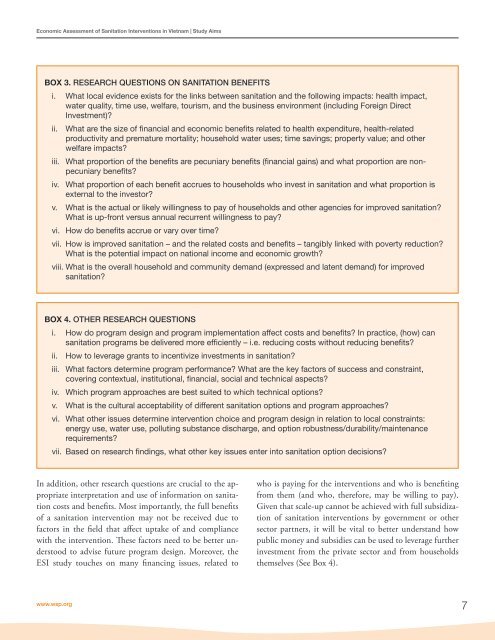Economic Assessment of Sanitation Interventions in Vietnam - WSP
Economic Assessment of Sanitation Interventions in Vietnam - WSP
Economic Assessment of Sanitation Interventions in Vietnam - WSP
Create successful ePaper yourself
Turn your PDF publications into a flip-book with our unique Google optimized e-Paper software.
<strong>Economic</strong> <strong>Assessment</strong> <strong>of</strong> <strong>Sanitation</strong> <strong>Interventions</strong> <strong>in</strong> <strong>Vietnam</strong> | Study AimsBOX 3. RESEARCH QUESTIONS ON SANITATION BENEFITSi. What local evidence exists for the l<strong>in</strong>ks between sanitation and the follow<strong>in</strong>g impacts: health impact,water quality, time use, welfare, tourism, and the bus<strong>in</strong>ess environment (<strong>in</strong>clud<strong>in</strong>g Foreign DirectInvestment)?ii. What are the size <strong>of</strong> f<strong>in</strong>ancial and economic benefits related to health expenditure, health-relatedproductivity and premature mortality; household water uses; time sav<strong>in</strong>gs; property value; and otherwelfare impacts?iii. What proportion <strong>of</strong> the benefits are pecuniary benefits (f<strong>in</strong>ancial ga<strong>in</strong>s) and what proportion are nonpecuniarybenefits?iv. What proportion <strong>of</strong> each benefit accrues to households who <strong>in</strong>vest <strong>in</strong> sanitation and what proportion isexternal to the <strong>in</strong>vestor?v. What is the actual or likely will<strong>in</strong>gness to pay <strong>of</strong> households and other agencies for improved sanitation?What is up-front versus annual recurrent will<strong>in</strong>gness to pay?vi. How do benefits accrue or vary over time?vii. How is improved sanitation – and the related costs and benefits – tangibly l<strong>in</strong>ked with poverty reduction?What is the potential impact on national <strong>in</strong>come and economic growth?viii. What is the overall household and community demand (expressed and latent demand) for improvedsanitation?BOX 4. OTHER RESEARCH QUESTIONSi. How do program design and program implementation affect costs and benefits? In practice, (how) cansanitation programs be delivered more efficiently – i.e. reduc<strong>in</strong>g costs without reduc<strong>in</strong>g benefits?ii. How to leverage grants to <strong>in</strong>centivize <strong>in</strong>vestments <strong>in</strong> sanitation?iii. What factors determ<strong>in</strong>e program performance? What are the key factors <strong>of</strong> success and constra<strong>in</strong>t,cover<strong>in</strong>g contextual, <strong>in</strong>stitutional, f<strong>in</strong>ancial, social and technical aspects?iv. Which program approaches are best suited to which technical options?v. What is the cultural acceptability <strong>of</strong> different sanitation options and program approaches?vi. What other issues determ<strong>in</strong>e <strong>in</strong>tervention choice and program design <strong>in</strong> relation to local constra<strong>in</strong>ts:energy use, water use, pollut<strong>in</strong>g substance discharge, and option robustness/durability/ma<strong>in</strong>tenancerequirements?vii. Based on research f<strong>in</strong>d<strong>in</strong>gs, what other key issues enter <strong>in</strong>to sanitation option decisions?In addition, other research questions are crucial to the appropriate<strong>in</strong>terpretation and use <strong>of</strong> <strong>in</strong>formation on sanitationcosts and benefits. Most importantly, the full benefits<strong>of</strong> a sanitation <strong>in</strong>tervention may not be received due t<strong>of</strong>actors <strong>in</strong> the field that affect uptake <strong>of</strong> and compliancewith the <strong>in</strong>tervention. These factors need to be better understoodto advise future program design. Moreover, theESI study touches on many f<strong>in</strong>anc<strong>in</strong>g issues, related towho is pay<strong>in</strong>g for the <strong>in</strong>terventions and who is benefit<strong>in</strong>gfrom them (and who, therefore, may be will<strong>in</strong>g to pay).Given that scale-up cannot be achieved with full subsidization<strong>of</strong> sanitation <strong>in</strong>terventions by government or othersector partners, it will be vital to better understand howpublic money and subsidies can be used to leverage further<strong>in</strong>vestment from the private sector and from householdsthemselves (See Box 4).www.wsp.org7
















